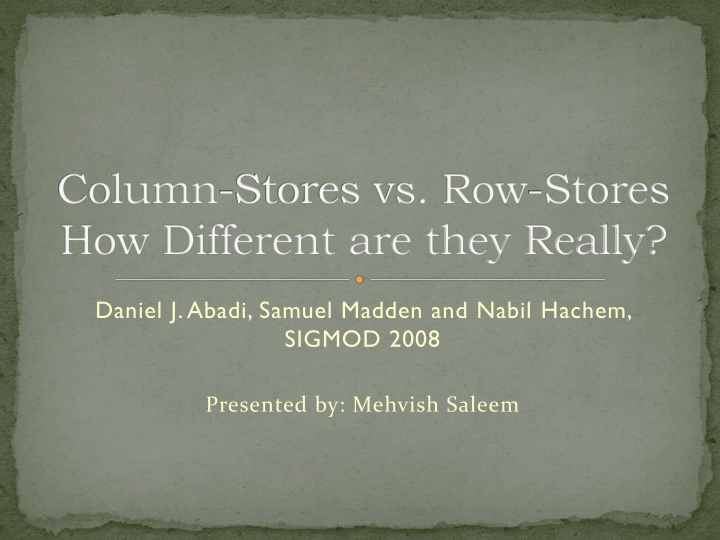Structural Differences Between Column and Row Stores
This study delves into the fundamental differences between column and row storage methods, discussing their impact on data organization, performance optimization, and storage efficiency in database systems.
Download Presentation

Please find below an Image/Link to download the presentation.
The content on the website is provided AS IS for your information and personal use only. It may not be sold, licensed, or shared on other websites without obtaining consent from the author.If you encounter any issues during the download, it is possible that the publisher has removed the file from their server.
You are allowed to download the files provided on this website for personal or commercial use, subject to the condition that they are used lawfully. All files are the property of their respective owners.
The content on the website is provided AS IS for your information and personal use only. It may not be sold, licensed, or shared on other websites without obtaining consent from the author.
E N D
Presentation Transcript
Column-Stores vs. Row-Stores How Different are they Really? Daniel J. Abadi, Samuel Madden and Nabil Hachem, SIGMOD 2008 Presented by: Mehvish Saleem
Contents Structural difference between column and row store Contributions Emulation of column-store in row store Column-oriented optimizations esp. Invisible join Column-store performance contributors Experiments and Results Conclusion
What is Column-Store? Row-store stores data in the disk tuple by tuple Column-store stores data in the disk column by column
Emulation of column-store in row-store Vertical partitioning Using index-only plans Using materialized views
Vertical Partitioning Full Vertical partitioning of each relation Each column = 1 Physical table Can be achieved by adding integer position column to every table Join on position for multi-column fetch Problems: Position - Space and disk bandwidth Header for every tuple further space wastage
Index-only plans Add B+Tree index for every Table column Plans never access the actual tuples on disk Headers are not stored, so per tuple overhead is less Problems: Separate indices may require full index scan, which is slower E.g.: SELECT AVG(salary) FROM emp WHERE age > 40
Materialized Views Create optimal' set of MVs for given query workload Objective: Provide just the required data Avoid overheads Performs better Expected to perform better than other two approach Problems: Require knowledge of query workloads in advance
Column-oriented execution Compression Late Materialization Block Iteration Invisible join
Compression Perform better on data with low information entropy Column-store data super compressible Improves performance Less space Less time spent in I/O
Late Materialization Delay Tuple Construction Might avoid constructing it altogether Eg: SELECT R.a FROM R WHERE R.c = 5 AND R.b = 10 Output of each predicate is a bit string Perform Bitwise AND Use final position list to extract R.a
Block Iteration Iterate over blocks of tuples rather than tuple-at-a-time Like batch processing If column is fixed width, it can be operated as an array Exploits potential for parallelism
Sample Query Find total revenue from Asian customers who purchase a product supplied by an Asian supplier between 1992 and 1997 grouped by nation of the customer, supplier and year of transaction
Purpose Comparing the performance of C-Store with column- store emulation in row-store Most significant optimization for column-stores Can unmodified row store obtain benefits of column- store?
C-Store VS System X RS: Base System X CS: Base C-Store RS (MV): System X with optimal collection of MVs CS (Row-MV): Column store constructed from RS(MV)
Different System X Configurations T: Traditional T(B): Traditional Bitmap MV: Materialized View VP: Vertical Partitioning AI: All Indexes
Results and Analysis MV performs best since they read minimal amount of data needed by a query Index only plans are the worst: Expensive column joins on fact table Vertical partitioning: Tuple overheads and reconstruction Column Store perform better than the best case of row store (4.0 sec VS 10.2 sec)
Conclusion Emulation of a column-store in a row-store does not yield good results Tuple reconstruction costs A pain to implement Most important optimizations for column-store: Compression and Late Materialization




